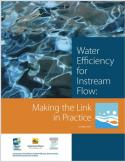Water Efficiency for Instream Flow

The Colorado River basin presents the greatest water management challenges of any river basin in the nation, with ever-expanding demands for multiple water uses, water demand exceeding supply, valued but fragile ecosystems, and support for nearly every type of water-relevant interest. The importance of instream flows–the amount of water flowing in a stream or river– is more pressing than ever, but in many parts of the basin, all water is spoken for.
The Alliance for Water Efficiency (AWE), American Rivers, ![]() and the Environmental Law Institute
and the Environmental Law Institute ![]() partnered on a project funded by The Walton Family Foundation to outline the practical possibilities for linking water efficiency efforts and healthier instream flows in the Colorado River basin. If a stretch of water is identified as needing improved instream flow, and a realistic opportunity for improving water efficiency exists, willing partners generally can build the bridges necessary to overcome other challenges. That is the principal finding of the report completed and released on November 14, 2011 by the three organizations.
partnered on a project funded by The Walton Family Foundation to outline the practical possibilities for linking water efficiency efforts and healthier instream flows in the Colorado River basin. If a stretch of water is identified as needing improved instream flow, and a realistic opportunity for improving water efficiency exists, willing partners generally can build the bridges necessary to overcome other challenges. That is the principal finding of the report completed and released on November 14, 2011 by the three organizations.
The project drew from the experience of an expert advisory committee and researched examples around the West of agricultural and municipal water efficiency efforts being used to improve instream flows. Through assessment of these examples, numerous interviews with water managers, and analysis of the laws and other unique characteristics of the seven states in which the Colorado River flows, the report identifies the challenges to and promising opportunities for linking water efficiency and instream flows in the basin.





